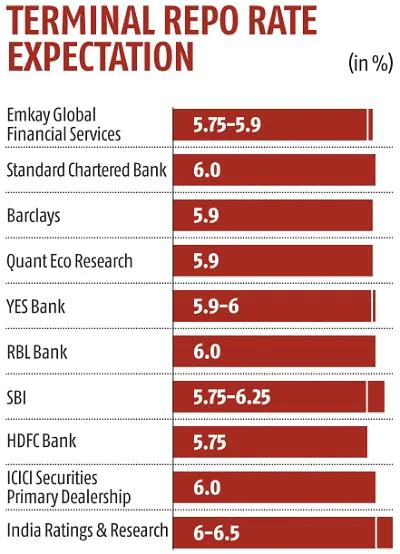Monetary policy review: Economists see repo rate climbing to around 6%
The Reserve Bank of India (RBI) is likely to increase the repo rate by almost 60 basis points more, taking it close to 6 per cent, before holding off on further policy tightening in the current cycle, economists told Business Standard.
According to the median of the inputs provided by 10 institutions, the terminal repo rate — or the rate at which the central bank stops tightening policy further — is seen at 5.98 per cent. The institutions are State Bank of India, HDFC Bank, Barclays, Standard Chartered Bank, YES Bank, RBL Bank, ICICI Securities Primary Dealership, India Ratings and Research, Quant Eco Research, and Emkay Global Financial Services.
The RBI’s Monetary Policy Committee (MPC) on Friday increased the repo rate by 50 basis points to 5.40 per cent. With the repo rate having been raised by 140 basis points since May, the RBI has now reversed the entire cuts announced after the pandemic struck India in March 2020.
At its current level, the repo rate is at its highest since August 2019.

Given that the central bank has retained its inflation forecast of 6.7 per cent for the current financial year despite its own observation about it having peaked, economists are unanimous that further tightening lies ahead.
“There is still a fair bit of uncertainty around inflation. Plus, it will remain above 6 per cent, which is their upper tolerance band for the foreseeable future. We were expecting them to continue frontloading,” HDFC Bank’s Principal Economist Sakshi Gupta said.
The consumer price index (CPI) inflation rate has remained above the upper limit of the RBI’s mandated 2-6 per cent range for six straight months up to June, when it was 7.01 per cent. The RBI’s medium-term target for CPI inflation is 4 per cent.
With the MPC predicting CPI inflation at 7.1 per cent in the current quarter, 6.4 per cent in October-December, and 5.8 per cent in January-March, it is almost certain it would fail in its mandate to ensure that average inflation does not stay above the upper threshold for three successive quarters. If that happens, the RBI has to give an explanation to the government. According to the MPC, CPI inflation is seen at 5 per cent in the first quarter of 2023-24. “The RBI governor said the inflation projection of 6.7 per cent for FY23 did not take into account the impact of monetary policy actions taken,” SBI Group Chief Economic Adviser Soumya Kanti Ghosh wrote.
According to Ghosh, it is possible that Friday’s rate hike will impact inflation over the longer term. Another possibility, according to him, is that the “… RBI does not want to put a lower inflation forecast at this time as it wants to remain ahead of the curve in an uncertain global environment of currencies and inflation”.
Some economists are, however, optimistic if the recent correction in global commodity prices is to sustain, the RBI will have the room to opt for a slower pace of rate hikes.
“Our terminal repo rate expectation has gone from 5.75 per cent to 5.90 per cent, but we are categorically saying that there is a possibility that after the October meeting they may end up pausing there,” Barclays Chief India Economist Rahul Bajoria said.
 Loan, Personal Loan, Home Loan, Business Loan,Loans in India Loan in India, Personal Loan, Home Loan, Business Loan, Loans in India,Loan Finance,Loan in India, Get Instant Personal Loan,Home Loan, Business Loans in India
Loan, Personal Loan, Home Loan, Business Loan,Loans in India Loan in India, Personal Loan, Home Loan, Business Loan, Loans in India,Loan Finance,Loan in India, Get Instant Personal Loan,Home Loan, Business Loans in India